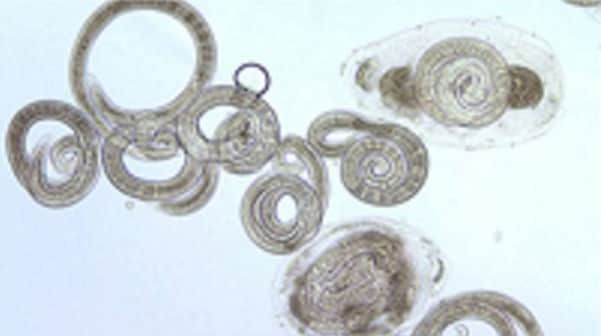Key points
- People who eat raw or undercooked meat from certain animals can get trichinellosis.
- Trichinellosis is a rare disease in the United States, and the risk of getting it is low.
- Trichinellosis symptoms can be mistaken for flu symptoms.
- Cooking meat to safe temperatures prevents trichinellosis.

Overview
Trichinellosis is an infection caused by the larvae of a parasitic worm. Parasites are living things that live on or inside other living things. People get trichinellosis, or trichinosis, after eating raw or undercooked meat that contains the parasite. Usually, meat contaminated with the Trichinella larvae comes from meat-eating animals such as bear, wild boar, or walrus.
Trichinellosis is a rare disease in the United States, with only about 15 confirmed cases per year. Worldwide, there are about 10,000 recorded cases per year. Trichinellosis can cause severe symptoms.
In the past, people in the U.S. often got the disease from eating undercooked or raw pork containing the larvae. Modern regulations on raising commercially farmed pigs and cooking guidelines for pork have helped to lower the risk of trichinellosis in this area.
Signs and symptoms
The signs, symptoms, severity, and duration of trichinellosis can vary. Symptoms often start with
- Nausea
- Diarrhea
- Tiredness
- Fever
- Abdominal (belly) discomfort
Symptoms can then progress to include
- Headache
- Fever
- Chills
- Cough
- Swelling of the face and eyes
- Aching joints and muscle pain
- Itchy skin
- Diarrhea
- Constipation
If the infection is heavy, you may have trouble coordinating movements, and have heart and breathing problems. Severe cases can cause death.
Risk factors
The risk of getting trichinellosis in the U.S. is very low. People who eat raw or undercooked pork or wild game, in particular, bear, wild boar, wildcat, fox, wolf, seal, or walrus are at risk of getting trichinellosis. Even tasting small amounts of such meat while it's raw or undercooked (like tasting the meat during preparation) puts you at risk for infection with Trichinella worms.
Homemade jerky and sausage made of these meats can also be sources for trichinellosis.
Fact
Prevention
The best way to prevent trichinellosis is to cook meat to safe temperatures Use a food thermometer to measure the internal temperature of cooked meat. Do not sample meat until it is properly cooked.
You should also
- Wash your hands with warm water and soap before preparing food and after handling raw meat.
- Freeze pork less than 6 inches thick for 20 days at 5°F (-15°C) to kill any worms.
- Clean meat grinders and all other tools thoroughly after each use.
Be aware that
- Curing (salting), drying, smoking, or microwaving meat alone does not consistently kill infective worms. Homemade jerky and sausage were the cause of many cases of trichinellosis reported to CDC in the past.
- Freezing wild game meats, unlike freezing pork products, may not effectively kill all worms because some worm species that infect wild game animals are freeze-resistant.
Four steps to Food Safety:
Diagnosis
If you have trichinellosis symptoms and may have eaten raw or undercooked meat, please speak with your healthcare provider. They may perform a laboratory test using a small sample of your blood to diagnose trichinellosis. Occasionally, a provider may recommend a muscle biopsy, where they look at a sample of your tissue under a microscope to detect trichinellosis.
Treatment and recovery
Safe and effective prescription drugs are available to treat trichinellosis and your symptoms. Treatment should begin as soon as possible. Your healthcare provider will make treatment decisions based on your symptoms, your exposure to raw or undercooked meat, and your laboratory test results.
